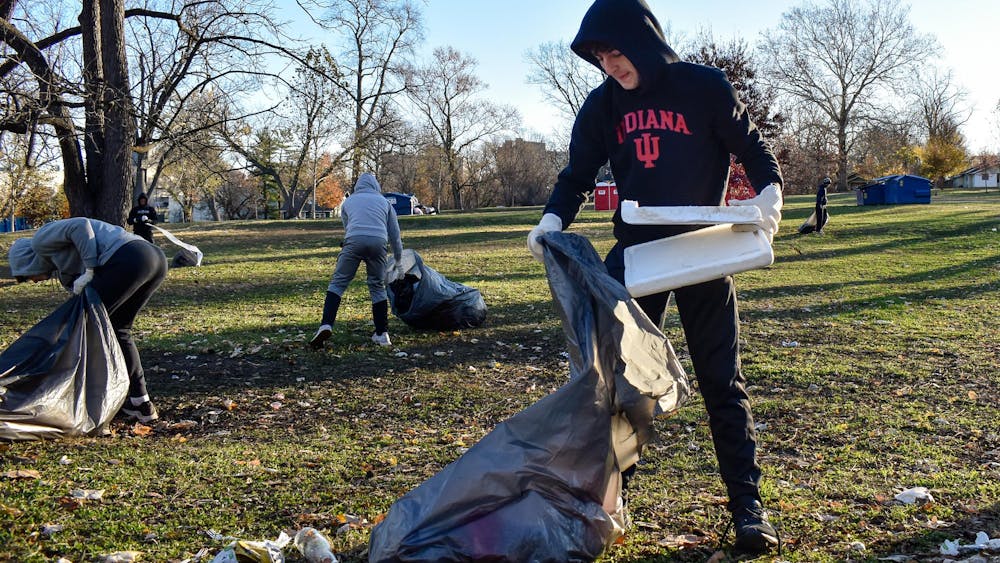Richard Shiffrin’s academic resume is, by almost anyone’s measure, distinguished. He has a bachelor’s degree from Yale University and a doctoral degree from Stanford University. He helped develop new theories on how we retrieve information from memory. After beginning his research and teaching career at IU in 1968, he founded the IU’s cognitive science program and became a distinguished professor in the department of psychological and brain sciences. \nBut on any given evening, you can find the 65-year-old professor hanging from a climbing rope halfway up a wall at Hoosier Heights, the Bloomington indoor rock climbing gym. \nRock climbing, and specifically routesetting, or constructing climbing routes indoors by arranging plastic holds on the vertical and overhanging walls, is Shiffrin’s non-academic passion. Shiffrin is the principal routesetter at the gym, which means he, along with only a select few other regular climbers, creates the routes everyone else climbs. While many people might assume Shiffrin sets his routes with slightly reckless young climbers in mind, in reality it is often IU employees who end up climbing on the holds he has set. At Hoosier Heights, a small group of IU-affiliated professionals has become a visible part of a growing climbing community. \nShiffrin said he began climbing about 12 years ago when a back problem made carrying a pack on hiking trips too painful. When Hoosier Heights opened in 1998, he said he noticed that there were not very many beginner-level climbing routes, which piqued his interest in setting such routes himself. \n“As I developed my climbing I also developed my routesetting, and I turned out to be a much better routesetter than a climber,” he said, laughing.\nNow, Shiffrin mostly uses his time at the gym to construct climbing routes up the walls to create any number of effects. Sometimes, Shiffrin’s goal is to set an easy route that first-time climbers can enjoy. Other times, the goal is to set a route so difficult only the most experienced and talented climbers can finish it. He always tries to place holds on the wall in such a way as to allow all climbers to move in creative ways that mimic climbing on natural rock. And there are plenty of IU employees ready to give his routes a try.\nThe reasons climbers such as Shiffrin climb at Hoosier Heights range from stress relief to the mental challenges the sport provides. This may explain why it seems to cater to more intellectual participants than other activities.\n“Climbing is not just a physical, repetitive activity,” said Nicole Schonemann, interim director of IU Community Outreach and Partnerships in Service-Learning. “It involves solving puzzles, so it’s always interesting and challenging.” \nIsaac Heacock, a graduate student in sociology who teaches a class on research \nmethods, agreed. \n“I think there is a unique mental challenge to climbing in the sense of figuring out how to solve a problem – how to figure out the sequence for a route,” he said. “Like, ‘How do I need to move my body in order to get up this wall?’” \nHoosier Heights currently allows students to put semester passes to the gym on their bursar accounts in an effort to attract IU students, but has no specific discounts or benefits for IU employees. Josh LaMar, a sophomore at IU and an employee at Hoosier Heights, said he thinks the gym is nonetheless popular with some IU employees because of the nature of rock climbing as an alternative sport. \n“More educated people could be interested in climbing because it’s kind of out there, and not something normal people do,” he said. Lamar was introduced to climbing by his father, Danny Rice who, fittingly, conducts research for IU’s Department of Biology. \nLindsay Watkins is the project manager for the Law School Study of Student Engagement, which examines effective educational practices for law schools as a part of the IU School of Education. She started climbing in Vermont, where she lived while in college, and began climbing regularly at Hoosier Heights when she moved to Bloomington. She said she thinks climbing might appeal to people affiliated with the university because the process of improving in climbing might mirror a larger desire for progress that is also found in academics. \n“If you climb a lot, you progress pretty steadily, usually,” Watkins said. “I’ve always sort of reached out (for new goals) and climbing is one way to do that.”\nYet for all its mental challenges, climbing may also serve as an escape from the day-to-day routine for IU employees.\n“You don’t need to think about school, you don’t need to think about writing a thesis, you don’t need to be thinking about the classes that you’re teaching,” said Tim VanHaitsma, who is pursuing a master’s degree in exercise physiology and teaches classes in both tennis and personal fitness. \nShiffrin said he hopes to continue setting routes at least until he turns 70. Whatever his personal reasons for doing so might be, it seems he’ll have plenty of fellow IU employees to climb them. \n“I do this in my off time,” Shiffrin said. “So when I get tired of doing intellectual activity at the university, I wander over (to Hoosier Heights) in the afternoon and set some routes.”
Higher education
IU professors enjoy mental challenges at hoosier heights

Get stories like this in your inbox
Subscribe





